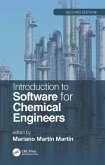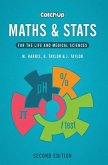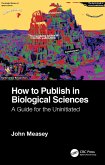Arthur T. Johnson (University of Maryland, College Park, USA)
Biology for Engineers, Second Edition
Arthur T. Johnson (University of Maryland, College Park, USA)
Biology for Engineers, Second Edition
- Gebundenes Buch
- Merkliste
- Auf die Merkliste
- Bewerten Bewerten
- Teilen
- Produkt teilen
- Produkterinnerung
- Produkterinnerung
This book gives a broad-range look at biological systems to establish fundamental understanding of living things from an engineering perspective.
Andere Kunden interessierten sich auch für
![Harper's Practical Genetic Counselling, Eighth Edition Harper's Practical Genetic Counselling, Eighth Edition]() Angus Clarke (Division of Cancer Clinical Professor & Sc GeneticsHarper's Practical Genetic Counselling, Eighth Edition79,99 €
Angus Clarke (Division of Cancer Clinical Professor & Sc GeneticsHarper's Practical Genetic Counselling, Eighth Edition79,99 €![Introduction to Software for Chemical Engineers, Second Edition Introduction to Software for Chemical Engineers, Second Edition]() Introduction to Software for Chemical Engineers, Second Edition122,99 €
Introduction to Software for Chemical Engineers, Second Edition122,99 €![Biological Clocks Biological Clocks]() Susan BinkleyBiological Clocks148,99 €
Susan BinkleyBiological Clocks148,99 €![Catch Up Maths & Stats, second edition Catch Up Maths & Stats, second edition]() Michael Harris (Severn School of Prima Associate Postgraduate DeanCatch Up Maths & Stats, second edition25,99 €
Michael Harris (Severn School of Prima Associate Postgraduate DeanCatch Up Maths & Stats, second edition25,99 €![How to Publish in Biological Sciences How to Publish in Biological Sciences]() John MeaseyHow to Publish in Biological Sciences26,99 €
John MeaseyHow to Publish in Biological Sciences26,99 €![Bio-Objects Bio-Objects]() Bio-Objects54,99 €
Bio-Objects54,99 €![How to Publish in Biological Sciences How to Publish in Biological Sciences]() John MeaseyHow to Publish in Biological Sciences66,99 €
John MeaseyHow to Publish in Biological Sciences66,99 €-
-
-
This book gives a broad-range look at biological systems to establish fundamental understanding of living things from an engineering perspective.
Produktdetails
- Produktdetails
- Verlag: Taylor & Francis Ltd
- 2 New edition
- Seitenzahl: 990
- Erscheinungstermin: 29. Oktober 2018
- Englisch
- Abmessung: 260mm x 183mm x 57mm
- Gewicht: 2158g
- ISBN-13: 9781138067899
- ISBN-10: 113806789X
- Artikelnr.: 54892499
- Herstellerkennzeichnung
- Libri GmbH
- Europaallee 1
- 36244 Bad Hersfeld
- gpsr@libri.de
- Verlag: Taylor & Francis Ltd
- 2 New edition
- Seitenzahl: 990
- Erscheinungstermin: 29. Oktober 2018
- Englisch
- Abmessung: 260mm x 183mm x 57mm
- Gewicht: 2158g
- ISBN-13: 9781138067899
- ISBN-10: 113806789X
- Artikelnr.: 54892499
- Herstellerkennzeichnung
- Libri GmbH
- Europaallee 1
- 36244 Bad Hersfeld
- gpsr@libri.de
Arthur T. Johnson received his Ph.D from Cornell University. He joined the faculty of Biomedical Engineering at the University of Maryland in 1979, where he remained as a tenured professor until he achieved Professor Emeritus status in 2009. He was cochairman of the committee to found the American Instutue for Medical and Biological Engineering (AIMBE) from 1988 to 1992, and served as the Executive Director of AIMBE in 2004. This is now considered the most prestigious organization within the biomedical engineering sciences. He has been President fo the Alliance for Engineering in Medicine and Biology (1984-1988), Institute for Biological Engineering (1998), and International Society for Repiratory Protection (2004-2009). He is a Founding Fellow for the American Institute for Medical and Biological Engineering (1995-1997), Life Fellow of the American Society for Engineering Education (1996), Life Fellow of the American Society for Agricultural and Biological Engineering (2002), Fellow of the American Industrial Hygiene Association (2005), Fellow of the Biomedical Engineering Society (2005), and a Life Fellow of the Institute of for Electrical and Electronics Engineers (IEEE - 2010). He has published three books, holds 24 patents and published over 200 peer reviewed journal articles largely dealing with engineering education, human performance and respiratory engineering and biosystems engineering. He has taught the biology for engineers course at the U of Maryland for the past 10 years. He also operates a 49 acre farm producting organically-raised fruit for sale at the local farmers' market.
Introduction. Science and Engineering. Scientific Method. Mathematical
Modeling. Biological Engineering. Expectations for Biological Engineers.
About Predictions. About This Book. Questions. Principles from the
Sciences. Principles of Physics. Effort and Flow Variables. Balances.
States of Matter. Equivalence of Work and Energy. Free Energy. Disorder and
Entropy. Heat Transfer. Movement of Materials. Fluid Mechanics. Solid
Mechanics. Electricity. Temperature Effects. Questions. Principles of
Chemistry. Chemical Equilibrium. Acids and Bases. Reaction Rates. Carbon
Chemistry. Physical Chemistry in Water. Protein Folding. Shape Effects and
Enzymes. Energy-Rich Compounds. Questions. Principles of Mathematics and
Engineering Sciences. Control Systems. Principles of Biology. Questions.
Responses of Living Systems. Biological Responses in Context (BRIC).
Questions. Scaling Factors. Allometric Relationships. Questions. Utilizing
Living Systems. Biological Engineering Solutions.
Modeling. Biological Engineering. Expectations for Biological Engineers.
About Predictions. About This Book. Questions. Principles from the
Sciences. Principles of Physics. Effort and Flow Variables. Balances.
States of Matter. Equivalence of Work and Energy. Free Energy. Disorder and
Entropy. Heat Transfer. Movement of Materials. Fluid Mechanics. Solid
Mechanics. Electricity. Temperature Effects. Questions. Principles of
Chemistry. Chemical Equilibrium. Acids and Bases. Reaction Rates. Carbon
Chemistry. Physical Chemistry in Water. Protein Folding. Shape Effects and
Enzymes. Energy-Rich Compounds. Questions. Principles of Mathematics and
Engineering Sciences. Control Systems. Principles of Biology. Questions.
Responses of Living Systems. Biological Responses in Context (BRIC).
Questions. Scaling Factors. Allometric Relationships. Questions. Utilizing
Living Systems. Biological Engineering Solutions.
Introduction. Science and Engineering. Scientific Method. Mathematical
Modeling. Biological Engineering. Expectations for Biological Engineers.
About Predictions. About This Book. Questions. Principles from the
Sciences. Principles of Physics. Effort and Flow Variables. Balances.
States of Matter. Equivalence of Work and Energy. Free Energy. Disorder and
Entropy. Heat Transfer. Movement of Materials. Fluid Mechanics. Solid
Mechanics. Electricity. Temperature Effects. Questions. Principles of
Chemistry. Chemical Equilibrium. Acids and Bases. Reaction Rates. Carbon
Chemistry. Physical Chemistry in Water. Protein Folding. Shape Effects and
Enzymes. Energy-Rich Compounds. Questions. Principles of Mathematics and
Engineering Sciences. Control Systems. Principles of Biology. Questions.
Responses of Living Systems. Biological Responses in Context (BRIC).
Questions. Scaling Factors. Allometric Relationships. Questions. Utilizing
Living Systems. Biological Engineering Solutions.
Modeling. Biological Engineering. Expectations for Biological Engineers.
About Predictions. About This Book. Questions. Principles from the
Sciences. Principles of Physics. Effort and Flow Variables. Balances.
States of Matter. Equivalence of Work and Energy. Free Energy. Disorder and
Entropy. Heat Transfer. Movement of Materials. Fluid Mechanics. Solid
Mechanics. Electricity. Temperature Effects. Questions. Principles of
Chemistry. Chemical Equilibrium. Acids and Bases. Reaction Rates. Carbon
Chemistry. Physical Chemistry in Water. Protein Folding. Shape Effects and
Enzymes. Energy-Rich Compounds. Questions. Principles of Mathematics and
Engineering Sciences. Control Systems. Principles of Biology. Questions.
Responses of Living Systems. Biological Responses in Context (BRIC).
Questions. Scaling Factors. Allometric Relationships. Questions. Utilizing
Living Systems. Biological Engineering Solutions.








